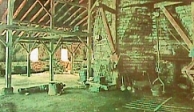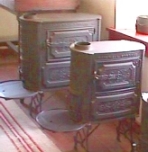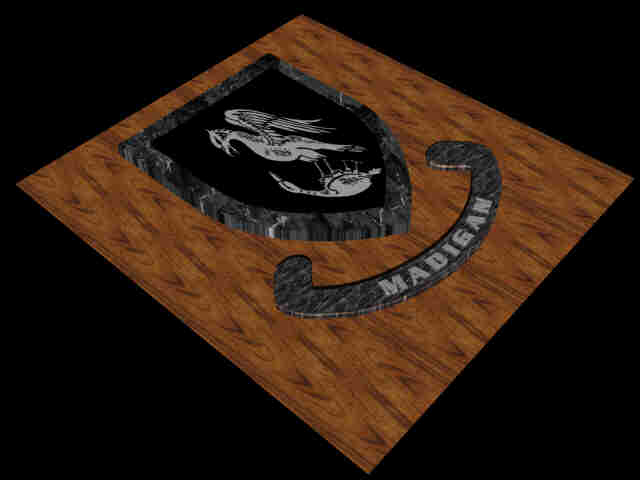Having learned a little bit about the beginnings we
started down towards the reconstructed village. The buildings,
other than the ironmaster's mansion and blacksmith shop, were
replicas of the buildings that might have been on the working
plantation. The iron workers actually lived on the property,
along with their wives and children and traded at the company
store. There was a barn there in which the livestock was kept.
This livestock provided milk, and dairy products as well as meat
for all the people living on the plantation. There was also the
blacksmith shop.
learned a little bit about the beginnings we
started down towards the reconstructed village. The buildings,
other than the ironmaster's mansion and blacksmith shop, were
replicas of the buildings that might have been on the working
plantation. The iron workers actually lived on the property,
along with their wives and children and traded at the company
store. There was a barn there in which the livestock was kept.
This livestock provided milk, and dairy products as well as meat
for all the people living on the plantation. There was also the
blacksmith shop. The very special thing about Hopewell was
that it wasn't just buildings but there were docents (lecturers
in costume) there re-enacting every aspect of the plantation
living. The first building we entered was the blast furnace where
we met two gentlemen who were demonstrating how the furnace
operated (using aluminum instead of iron). These men, Dave Tatum
and Dennis Bukovsky, had volunteered at Hopewell for 20 and 17
years respectively. After the demonstration we talked with them
and found out that they were teachers at a local school, who
enjoyed making history come alive for the children and adults who
visited. After this we walked around looking at the various
buildings. In one of the cottages
The very special thing about Hopewell was
that it wasn't just buildings but there were docents (lecturers
in costume) there re-enacting every aspect of the plantation
living. The first building we entered was the blast furnace where
we met two gentlemen who were demonstrating how the furnace
operated (using aluminum instead of iron). These men, Dave Tatum
and Dennis Bukovsky, had volunteered at Hopewell for 20 and 17
years respectively. After the demonstration we talked with them
and found out that they were teachers at a local school, who
enjoyed making history come alive for the children and adults who
visited. After this we walked around looking at the various
buildings. In one of the cottages we saw a lady,
Colleen Schulze, portraying the character of Mrs. Dunwoody. She
was demonstrating how to cook on an open hearth. (I have a hard
enough time cooking on a modern stove-God help anyone who'd have
to eat my cooking on an open hearth). Bob tried to talk them into
letting him have a taste, but one of the rangers nearby said that
the health department would not allow them to feed anyone except
park employees. At least Bob got to pose with some of the food.
After we left there we met a man who
we saw a lady,
Colleen Schulze, portraying the character of Mrs. Dunwoody. She
was demonstrating how to cook on an open hearth. (I have a hard
enough time cooking on a modern stove-God help anyone who'd have
to eat my cooking on an open hearth). Bob tried to talk them into
letting him have a taste, but one of the rangers nearby said that
the health department would not allow them to feed anyone except
park employees. At least Bob got to pose with some of the food.
After we left there we met a man who tended the livestock on the property. His
name was Jim Boyce. Jim, like Colleen, was dressed in period
costume. The company store was particularly interesting. The
books indicated that everything the employees bought was charged
against credits for work. Everything they needed to live on was
there. We have to remember that in those days they didn't have a Wal-mart down the road to get their necessities for living. Also,
if anyone needed anything that wasn't carried by the store they
could request it, it would be ordered and they would be notified
when it came in. There was also a large display of the stoves
that had been made on the property.
tended the livestock on the property. His
name was Jim Boyce. Jim, like Colleen, was dressed in period
costume. The company store was particularly interesting. The
books indicated that everything the employees bought was charged
against credits for work. Everything they needed to live on was
there. We have to remember that in those days they didn't have a Wal-mart down the road to get their necessities for living. Also,
if anyone needed anything that wasn't carried by the store they
could request it, it would be ordered and they would be notified
when it came in. There was also a large display of the stoves
that had been made on the property.
The ironmaster's house was really lovely. It served as residence
for the ironmaster and his family as well as his office. In
addition, it served as a type of boarding house for anyone who
came to do business with the ironmaster. The table was often set
for many more people than just the ironmaster and his family. The
house was furnished with some of the furnishings from the
original families but lot of the furniture inside were pieces
that were used during that time (but not necessarily exact pieces
that had been there). You were allowed to go through on your own.
Again, the audio boxes gave you information on the various rooms.
 In addition to the live characters they had
throughout the property, each building had an audio program that
you could activate by pushing a button and listening at your leisure. Each audio program was done in a different voice, by
someone speaking as though they were a person who had worked in
that building during the time that the plantation was in
operation. For example: in the spring house, the voice was that
of a young woman who talked about how many hours they worked
doing the chores that needed to be done in that place. It made me
feel as though I had stepped back in time and was talking to one
of the serving girls from "the big house."
In addition to the live characters they had
throughout the property, each building had an audio program that
you could activate by pushing a button and listening at your leisure. Each audio program was done in a different voice, by
someone speaking as though they were a person who had worked in
that building during the time that the plantation was in
operation. For example: in the spring house, the voice was that
of a young woman who talked about how many hours they worked
doing the chores that needed to be done in that place. It made me
feel as though I had stepped back in time and was talking to one
of the serving girls from "the big house."
There are numerous activities that are held during the year. For
further information about Hopewell Furnace you can check their
website.
*** THE END ***
Good Luck! Have Fun! and Stay Safe!
Laura
